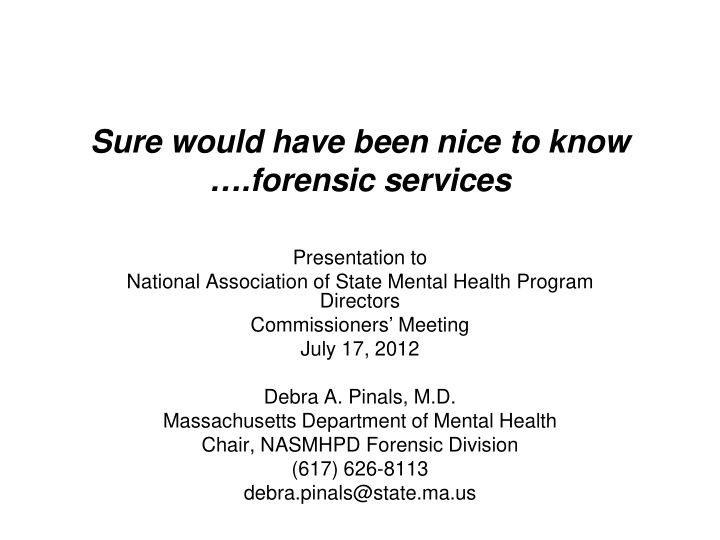



Sure would have been nice to know ….forensic services Presentation to National Association of State Mental Health Program Directors Commissioners’ Meeting July 17, 2012 Debra A. Pinals, M.D. Massachusetts Department of Mental Health Chair, NASMHPD Forensic Division (617) 626-8113 debra.pinals@state.ma.us
The Commissioner Dream • Champion of individuals with mental illness • The ability to set policy that promotes wellness, recovery, and maximizing the potential of consumers to live meaningful lives • The ability to impact the roadmap for the future • The ability to think creatively and use years of well-built leadership skills
Surprise, surprise • Key role of the State Public Mental Health system as a manager of forensic services – Forensic evaluations of competence to stand trial (over 60,000 per year!), sanity at the time of the offense, aid in sentencing, etc. – Management of committed forensic patients – Management of sex offenders – Management of mental health services in Jails and prisons
Forensic Services • A world with a – Different language – Conservative culture – Sensitivity to safety,risk and bad outcomes – Specialized skill set clinicians – Highly politicized – High potential for media exposure
The Push Me - Pull You Dilemma Bad Outcomes Increased public safety concerns Tighter oversight Laws Limiting release decisions Disproportionate Rise in Forensic Advocate focused Beds as Civil Beds Person Centered have closed Maximized autonomy Increased Community Access
SMHA-Controlled Forensic and Sex Offender Mental Health Expenditures, FY 1983– FY 2005
How did they get here? A focus on competence to stand trial and diversion • Understanding the trial highway • Arrest • Court • Sentencing
Competence to Stand Trial • Emerged out of 17 th Century Law • Grounded in constitutional rights • Grounded in fairness, accuracy, integrity, and dignity • Most frequently raised issue among the criminal competencies
Competence to Stand Trial • Questioned in 10-15% of public defense cases • Est. 60,000 CST evaluations per year • 9000 defendants/year found Incompetent • 12000-15000 defendants/year committed as Incompetent to Stand Trial • 100:1 compared to those found NGRI • Psychosis and MR/ID most common reason for Incompetence finding
Mechanics and the SMHA • Laws authorize the Commissioner to train and certify evaluators • Forensic Directors help translate, assure quality • In some states, outpatient competence evaluations occur first and hospitalization decisions rely on forensic evaluators (but…courts trump) • In many states, incompetent defendants may end up waiting in jail for hospital “restoration bed”
Restoration Statute Key Features (examples) (Mossman et al 2007) State Test for Restorability Maximum Time for Restoration MA Not specified Not really specified. IST committed for ½ max time or max time prior to parole eligibility OH Likelihood of being restored within 30 or 60 d for one year if treated misdemeanors; 6 months for lesser felonies; 12 months for major felonies GA Substantial probability of attaining One year competence to stand trial in foreseeable future AZ Substantial probability defendant The lesser of 21 months or will regain competence within 21 the maximum sentence for months of original finding of the offense incompetence
Restoration as Mandate • Mandated period in most states related to attempting to get individual competent and back to court • Often admission is more easily achieved than release – Studies demonstrate that individuals with similar behav who end up in criminal justice door end up hospitalized longer
Competence Restoration • Psychotropic medications – Mainstay of restoration for MI defendants – Legal risks of medications raised – Legal benefits of medications – Voluntary vs. Involuntary medication
Competence Restoration • Non-pharmacological competence restoration
Restoration as the Tip of the Iceberg • Over-representation of persons with a range of mental health and substance use disorders in the criminal justice system (yes, it’s true it works both ways) • Costs (financial and societal) associated with revolving door of incarceration as opposed to treatment • Mental health systems may be seen as the “problem” (e.g. “transinstitutionalization”) but more often now can be a critical part of solutions! • Shared Goals: improving mental health outcomes and aiming to help public safety
The Current Era: Diversion • Efforts to “reduce the penetration of persons with mental illness from the criminal justice system” when appropriate and safe • Requires – Identification – Linkage • Sequential Intercept model (Munetz and Griffin 2006)
Restoration Innovations as “Diversion” strategies • Innovations: – TN: Contracted evaluators provide one or two “restoration sessions” in community- diverting 89% (63/71) of recent cases – GA: Jail restoration contracted services dramatic reduction in hospital waitlist from more than a hundred to almost zero – Other: Pre-trial diversion strategies
Mental Health and Substance Abuse Intercepts in the Criminal Justice Process: A Broad Overview Local Law Enforcement Prison Parole Appearance Court Initial COMMUNITY COMMUNITY Dispositional Initial Detention Arrest Jail Court /Booking Jail— Probation Specialty Sentenced Court Intercept 1 Intercept 2 Intercept 3 Intercept 4 Intercept 5 Law Booking/ Initial Jails, courts Jail re-entry Community enforcement/ Appearance corrections/ emergency community services support
Targeted Innovations Along the Intercepts…a few ideas • Pre-arrest diversion – MA: Invests 750K in police based diversion with varying models • Court-based diversion – Numerous states: Mental Health Courts emerging (over 200) • Re-entry based diversion/prevention of re-arrest – NY: Re-entry initiatives, FACT teams, etc. – MA: Forensic Transition Team
SMHA and the Broad Policy Framework • Targeted interventions across the intercept points • Do a scan of current activities • Assess investment diversification • Diversion, risk management, quality forensic services • Best forensic systems are the best prevention systems to allow realization of more SMHA goals… • Get to know your forensic division directors!!!!
Recommend
More recommend